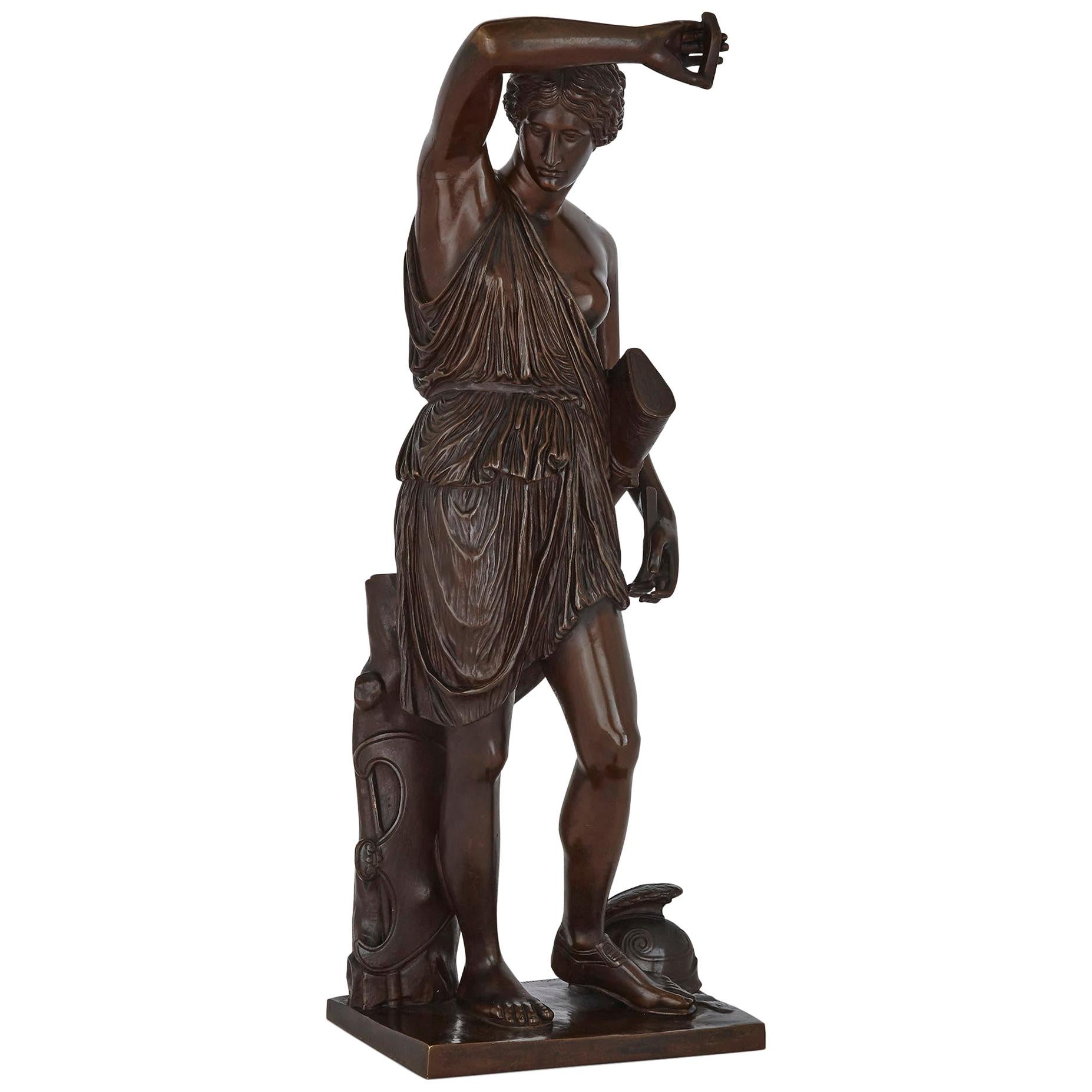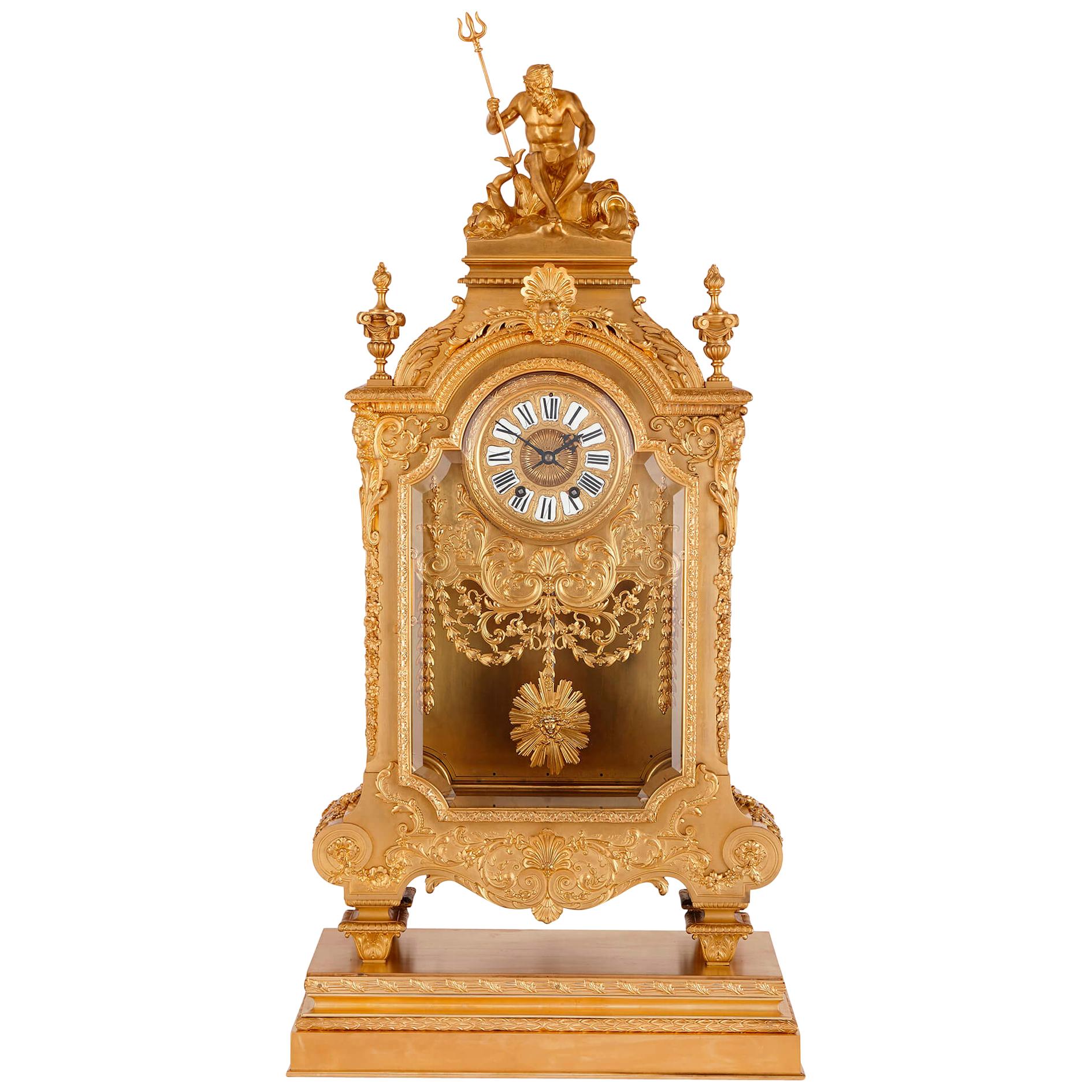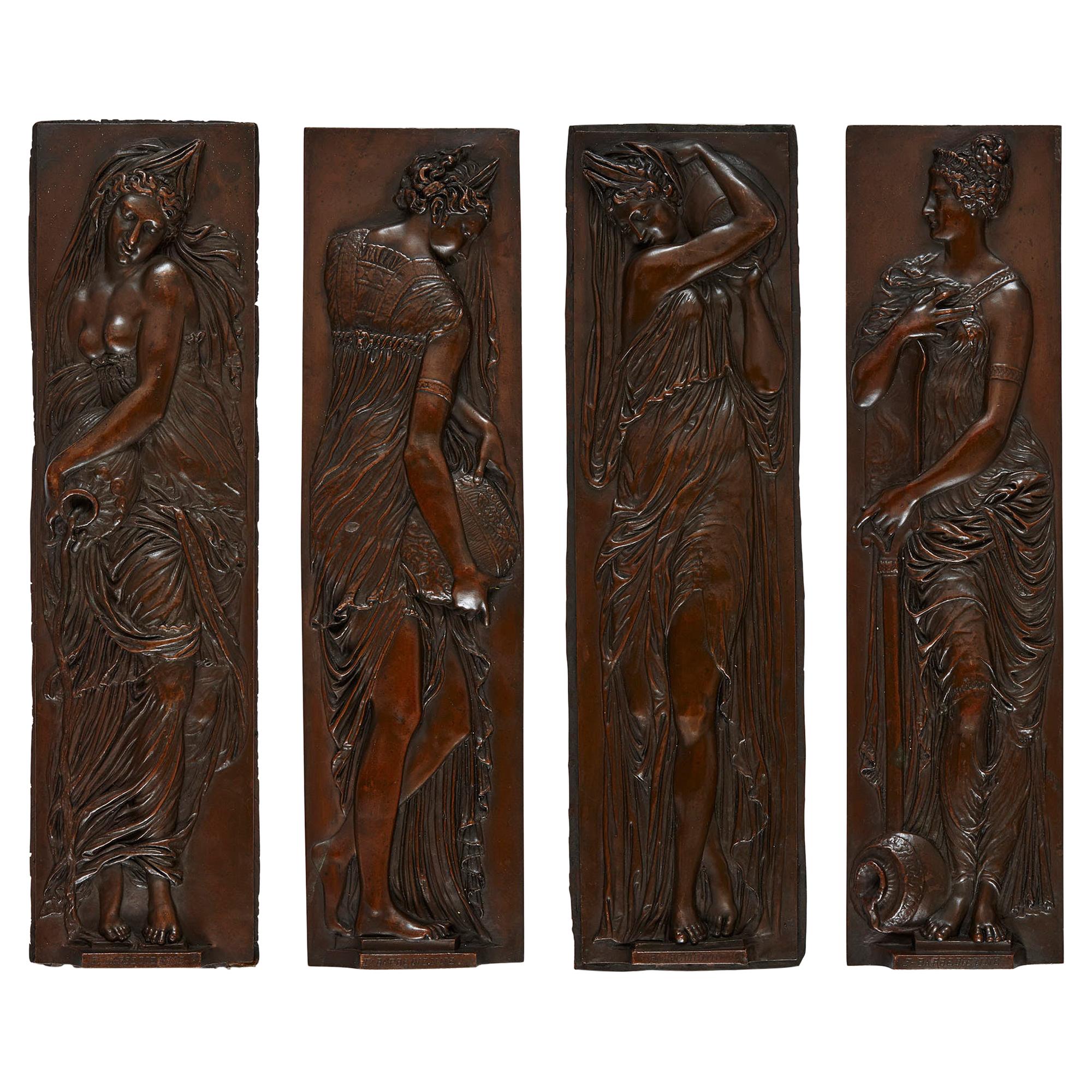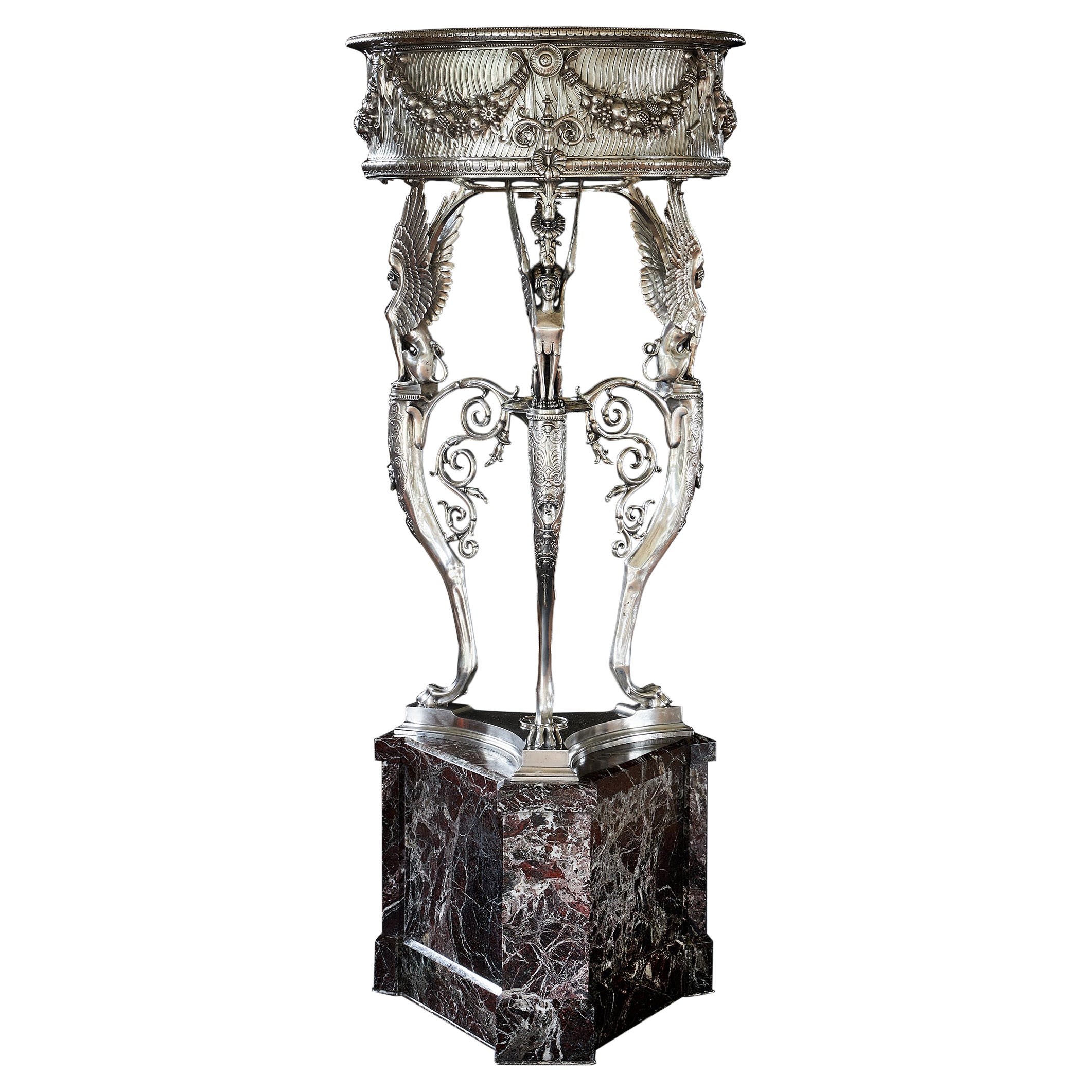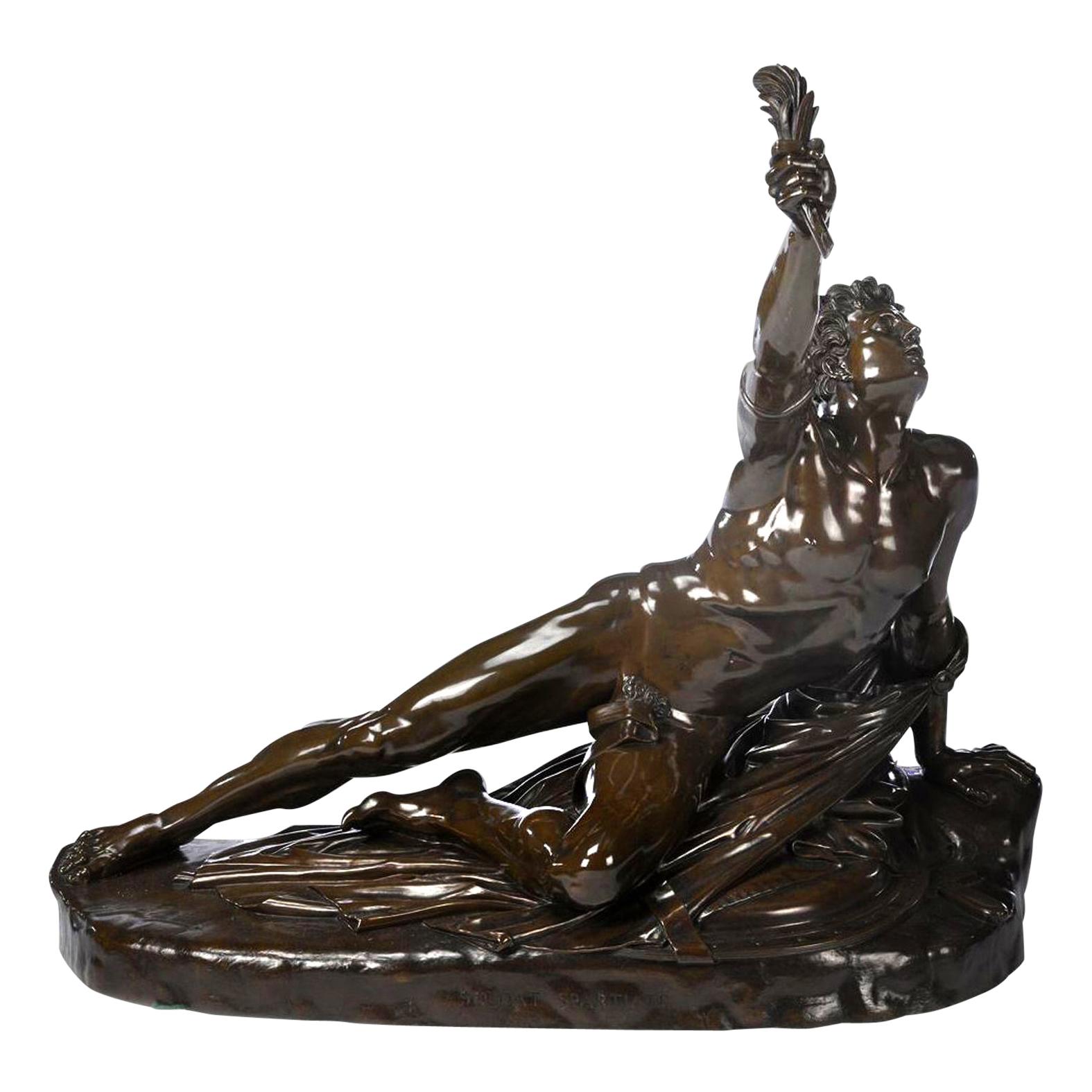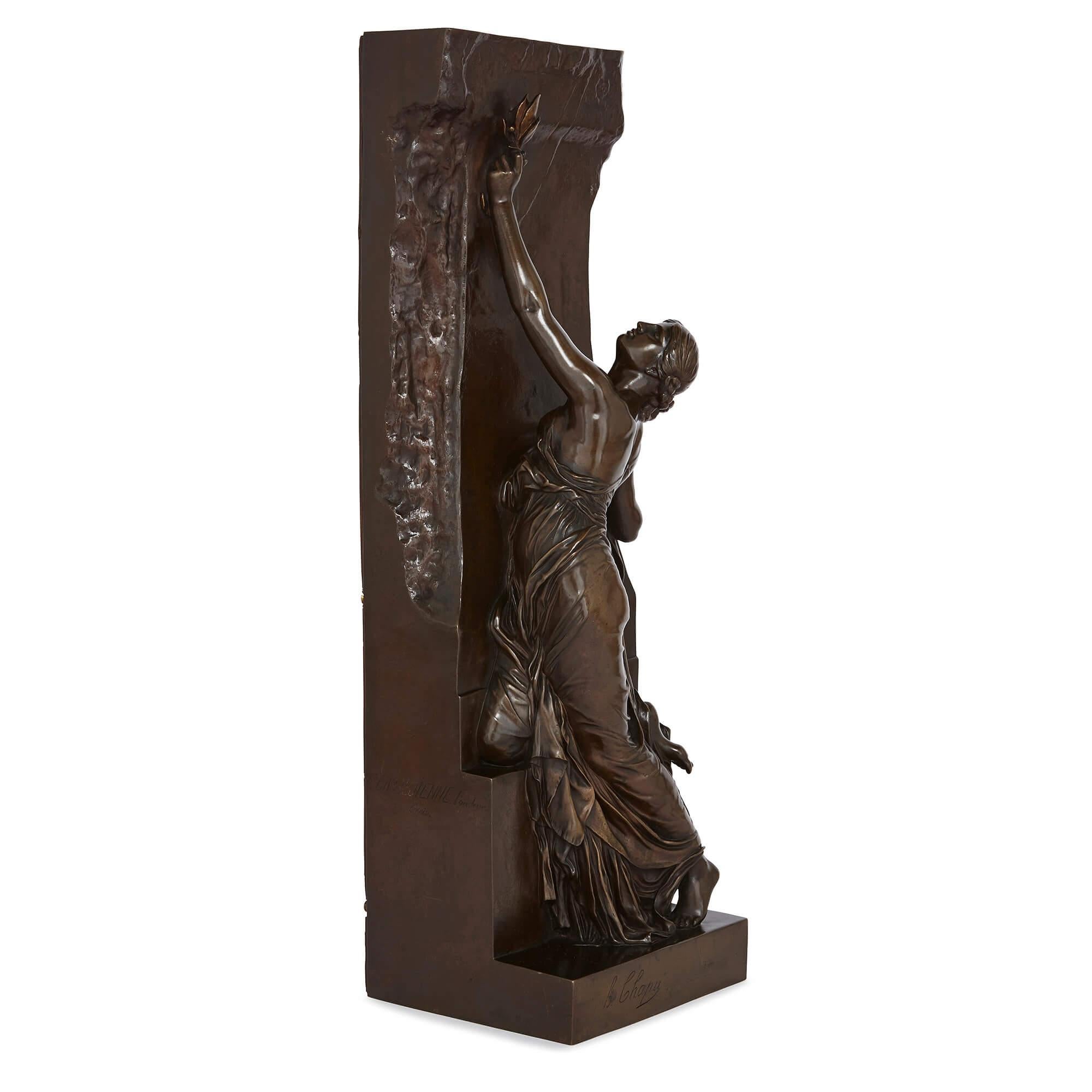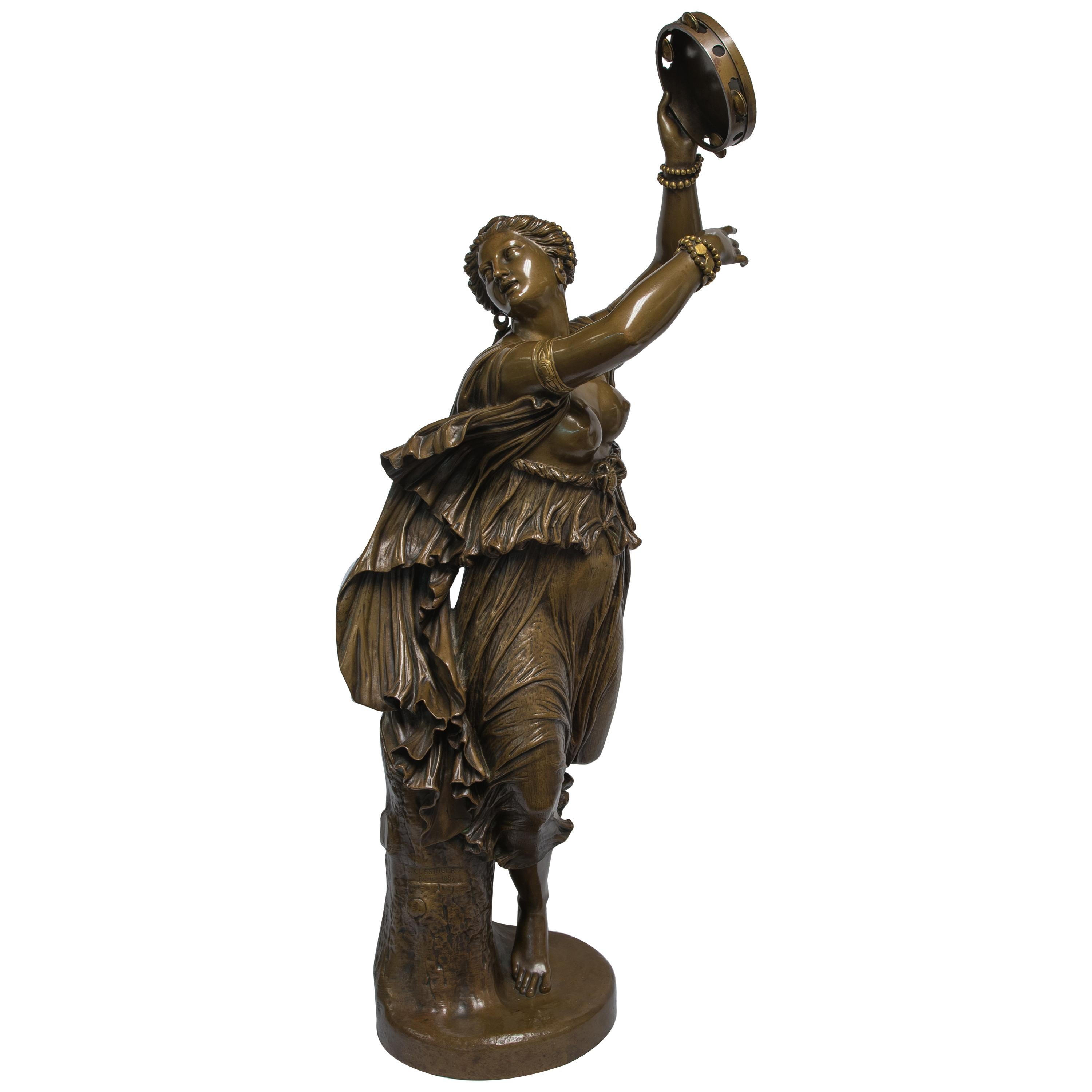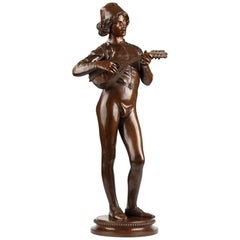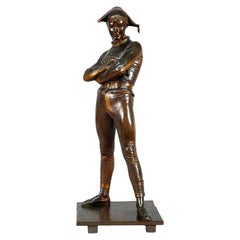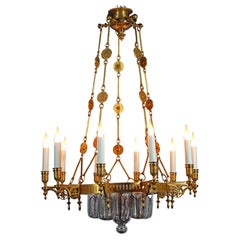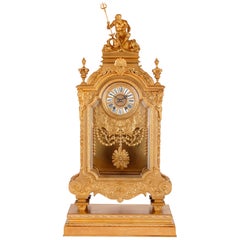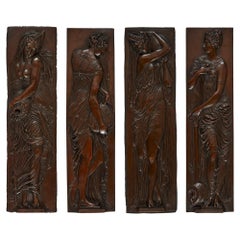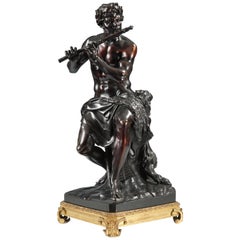
"Sheperd Playing His Flute" by F. Barbedienne
View Similar Items
"Sheperd Playing His Flute" by F. Barbedienne
About the Item
- Creator:Ferdinand Barbedienne (Maker)
- Dimensions:Height: 23.63 in (60 cm)Diameter: 10.24 in (26 cm)Length: 23.63 in (60 cm)
- Materials and Techniques:
- Place of Origin:
- Period:
- Date of Manufacture:circa 1880
- Condition:
- Seller Location:PARIS, FR
- Reference Number:Seller: 0702/931stDibs: LU3860312490642
Ferdinand Barbedienne
Founded by one-time Parisian wallpaper dealer Ferdinand Barbedienne and engineer Achille Collas, one of the most revered foundries in 19th-century France began with the invention of a revolutionary 1830s-era device that could produce proportional reproductions — large or small — of sculptures. Collas’s machine, which yielded miniature likenesses of antiquities for the interiors of homes the world over, was pivotal to the success of the F. Barbedienne Foundry. The successful firm earned prestigious awards and critical acclaim and created exquisite bronze candleholders, clocks and lamps for a range of wealthy and prominent clients.
The duo first launched their company under the name Société Collas et Barbedienne, and early on, they optimized chemical processes for pigmenting and patinating their bronze statuettes. After Collas died in 1859, Barbedienne forged on alone, and the company’s name changed to simply F. Barbedienne.
Barbedienne employed more than 300 workers at that point, and the Maison created a range of furnishings and decorative objects that featured the integration of marble and ormolu accents. However, with the onset of the Franco-Prussian War of 1870, the foundry was forced to retrofit its molds, and the production of cannons replaced sculptures, furniture and vases.
When Ferdinand Barbedienne passed away in 1891, his nephew and heir, Gustave Leblanc, took over as president, changing the name to Leblanc-Barbedienne. Leblanc expanded production into Germany, the United Kingdom and the United States, carrying on the company's legacy with monumental sculptures, and models and securing production rights for famous statues. Paul-Alexandre Dumas, an Art Nouveau maker and student of Louis Majorelle, succeeded Leblanc until the company's closing in 1952.
Barbedienne pieces had been exhibited regularly in the 19th century and were especially prevalent at Europe’s international expositions and world’s fairs, where they received numerous prizes. Today, the Musée d’Orsay in Paris holds dozens of Barbedienne works in its collection, including intricate mirrors, vases and cups created by Louis-Constant Sévin at the foundry. For more than two decades, Sévin created lamps, boxes and more at Maison Barbedienne. Working alongside award-winning chaser Désiré Attarge, Sévin designed Napoleon III-era works that greatly appealed to European nobility.
Other notable artists who collaborated with Barbedienne included Eugene Aizelin, Emmanuel Fremiet, Antonin Mercié, Emile Guillemin, Edouard Lievre, Ferdinand Levillain and Auguste Rodin.
On 1stDibs, find a collection of antique Ferdinand Barbedienne decorative objects, lighting and more.
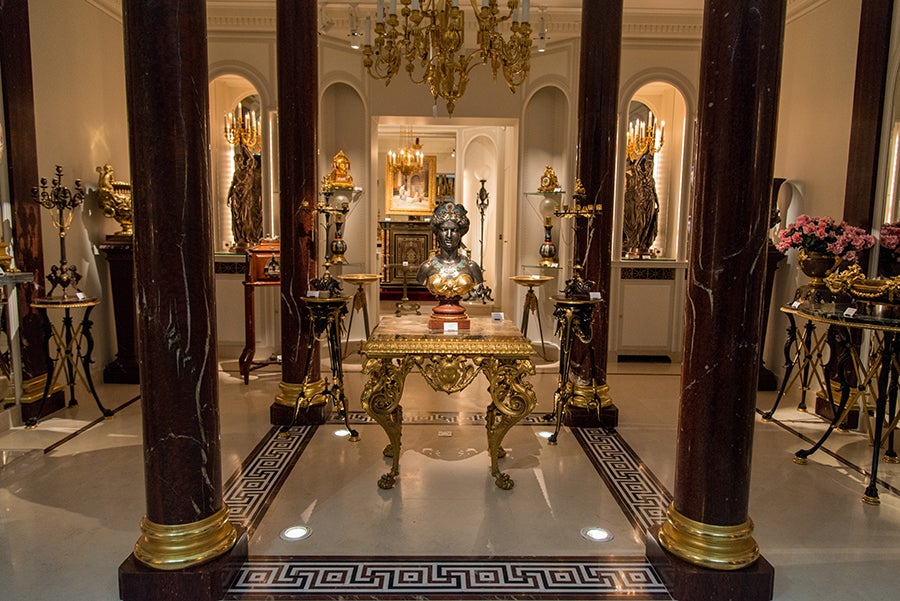
- "Florentine Singer" Bronze Sculpture by P. Dubois and F. Barbedienne, Circa 1880By Paul Dubois, Ferdinand BarbedienneLocated in PARIS, FRSigned P. Dubois 1865 and F. Barbedienne fondeur Stamped with réduction mécanique Collas A patinated bronze « Florentine Singer » sculpture, inspir...Category
Antique 1880s French Figurative Sculptures
MaterialsBronze
- Harlequin by R. de Saint Marceaux, Cast by F. Barbedienne, France, Circa 1880By René de Saint-Marceaux, F. Barbedienne FoundryLocated in PARIS, FRSignature of René Saint-Marceaux and dated 1879 Signed F. Barbedienne Fondeur Paris A. Collas Mechanical Reduction Stamps Reduced Size: 3/5 Elegant statue of a standing Harlequin, ...Category
Antique 1880s French Figurative Sculptures
MaterialsBronze
- Ottoman Style Chandelier by F. Barbedienne, France, circa 1880By Ferdinand BarbedienneLocated in PARIS, FRSigned F. Barbedienne Rare Ottoman style gilded bronze chandelier composed of an openwork crown, from which ten arms of light emerge, holding six transparent glasses decorated with ...Category
Antique 1880s French Islamic Chandeliers and Pendants
MaterialsBronze
- Large Neo-Greek Vase by F. Levillain & F. Barbedienne, France, circa 1890By Ferdinand Barbedienne, Ferdinand LevillainLocated in PARIS, FRImportant neo-Greek vase in the shape of an Amphora, made in two patina bronze. The body is decorated with a rich continuous frieze in bas-relief presenting a procession of characters carrying their offerings to the temple, underlined by a decoration of theatrical masks among olive trees. The 's'-scroll handles decorated with grape vines, resting only on the shoulder of the vase, are supported by a ram’s head. Numerous palmettes and friezes adorn the whole. Resting on a molded marble circular base. Biography Ferdinand Levillain (Paris, 1837-1905) studied under the sculptor Jouffroy (1806-1882), before making his debut in 1861 at the French Artists Salon where he continued to exhibit until 1903. At the 1867 Universal Exhibition in Paris, he was praised for a Neo-Greek style bronze cup he made for the firm Blot and Drouard. He was not to become really famous, however, until 1871 thanks to his association with the great bronze founder Ferdinand Barbedienne, who began to exhibit Neo-Greek style lamps...Category
Antique 1890s French Greek Revival Vases
MaterialsMarble, Bronze
- Pair of Neo-Greek Andirons by F. Barbedienne, France, Circa 1870By Ferdinand BarbedienneLocated in PARIS, FRMeasures: Height : 47 cm (18,5 in.) ; Width : 70 up to 96 cm (27,5 – 37,8 in.) ; Depth : 6 cm (2,3 in.) A rare pair of square shaped andirons, made in gilded bronze and polychrome...Category
Antique 1870s French Greek Revival Fireplace Tools and Chimney Pots
MaterialsBronze, Enamel
$13,558 Sale Price / set25% Off - Elegant Pair of Bronze Torcheres by F. Barbedienne, P. Dubois and A. FalguièreBy Paul Dubois, Jean Alexandre Joseph Falguière 1, Ferdinand BarbedienneLocated in PARIS, FRMODEL PRESENTED AT THE 1867 PARIS UNIVERSAL EXHIBITION Listed in the Ferdinand Barbedienne’s catalogue as the “Deux femmes debout” (Two standing ladies) Signed on each one P. Dubois – F. Barbedienne Fondeur and A. Falguière – F. Barbedienne Fondeur Rare pair of parcel-gilt and patinated bronze figures, representing two women dressed in Antique style costume with jewels, each upholding a seven lights-arm candelabra. Standing on round bronze bases and black marble socles. Paul Dubois (1827-1905) entered the Paris Beaux-Arts School in 1858. He exhibited at the 1865 Salon the Chanteur Florentin, illustrating Florentine sculpture, observed after his journey in Italy. This work, cast that time in silvered bronze, was exhibited at the 1867 Paris Universal Exhibition (now preserved at the Orsay museum). Dubois' success brought him many commissions, both private (Portrait of Duc d'Aumale) and public (Jeanne d'Arc, in Reims). Appointed curator at the Luxembourg museum in 1873, Dubois became also a member of the Institute and finally headmaster at the Beaux-Arts School in 1878. Alexandre Falguière (1831-1900) studied under Jouffroy at the Paris Ecole des Beaux-Arts, began his career at the Paris Salon in 1857 and won as soon as 1859 the “Prix de Rome”. Falguière became very quickly successful and was several times awarded medals at the Salon, such in 1868 with his marble sculpture Tarcisius the Christian Boy-Martyr, or at the 1867 Paris Universal Exhibition, where he won the first medal in his category. Thanks to that success, he was immediately commissioned by private collectors as well as by the French State, whom asked him in 1878 to realize the Triomphe de la République, placed in 1881 at the summit of the Paris Arch of Triumph...Category
Antique 1860s French More Lighting
MaterialsBronze
- Antique Patinated Bronze Sculpture of Diana by Ferdinand BarbedienneBy Ferdinand BarbedienneLocated in London, GBAntique Patinated Bronze Sculpture of Diana by Ferdinand Barbedienne French, late 19th Century Dimensions: Height 60cm, width 22cm, depth 22cm This...Category
Antique Late 19th Century French Neoclassical Figurative Sculptures
MaterialsBronze
- Antique Gilt Bronze Mantel Clock by Sevin and BarbedienneBy Ferdinand Barbedienne, Louis-Constant SevinLocated in London, GBThis ormolu clock is an exemplary work by the famous French 19th century metalworker and foundry-owner, Ferdiand Barbedienne. Working with a design made by the acclaimed onamentalist, Louis-Constant...Category
Antique Late 19th Century French Neoclassical Mantel Clocks
MaterialsOrmolu, Bronze
- Set of Four Spelter Plaques by Ferdinand BarbedienneBy Ferdinand BarbedienneLocated in London, GBSet of four spelter plaques by Ferdinand Barbedienne French, late 19th century Measures: Height 45cm, width 12cm, depth 0.5 cm This set of four pla...Category
Antique Late 19th Century French Neoclassical Figurative Sculptures
MaterialsSpelter
- Classical Style Bronze Sculpture of Penelope by Cavelier and BarbedienneBy Pierre-Jules Cavelier, Ferdinand BarbedienneLocated in London, GBThis large patinated bronze antique sculpture depicts the Classical figure Penelope, the wife of Odysseus (Roman name Ulysses) who appears in ...Category
Antique Late 19th Century French Neoclassical Revival Figurative Sculptures
MaterialsBronze
- 19th Century Silvered Bronze Athénienne Jardinière by Ferdinand BarbedienneBy Ferdinand BarbedienneLocated in Oxfordshire, United KingdomA French silvered-bronze athénienne by Ferdinand Barbedienne, Paris, last quarter 19th century with a revolving liner, the frieze applied with bucrania suspending ribbon-tied berried laurel swags above a border of bellflowers on a stippled ground above three seated female sphinxes issuing stylised foliage and scrolls on lion monopodia cast with the mask of Hercules, scrolling foliage and anthemions joined by stretchers, raised on a concave-sided triform marble base on a further thin silvered-bronze base, inscribed to the tripod base 'F. BARBEDIENNE' Measures: 103.3cm. high, 41.5cm. diameter; 3ft. 4 3/8 in, 1ft. 4 1/4. This impressive athénienne is a key reminder of the longevity of a particular model and design’s success from Antiquity through to the 19th century and up until this day. Typically known as the ‘Trépied du Temple d’Isis’, this athénienne is designed after the Roman antique originally found at Pompeii and now at the Museo Archeologico Nazionale, Naples (fig.1). From being for example an inspiration for the baptismal font of Napoléon’s son in 1811, this model was the inspiration to many highly skilled makers throughout the 19thcentury such as the Manfredini brothers from Milan and of course the Parisian well-established bronze founder Ferdinand Barbedienne who executed the present example. The Temple of Isis was a Roman temple dedicated to the Egyptian goddess Isis and was among one of the first discoveries during the excavation of Pompeii in 1764. Certainly considered as one of the most elegant examples of antique tripods, the existence of this model was then popularized to the rest of Europe via prints, one of the first being by Giovanni Battista Piranesi in 1779. This type of tripod was also popularised by an engraving in C. Percier and P. Fontaine’s, Receuil de Décorations Intérieures of 1801. Interestingly, there is also a watercolour now in the Musée Carnavalet, Paris, showing this type of tripod displayed at the 1801 Exposition des Produits de L’Industrie in the Louvre. The passion for Greek and Roman Art in the 19th century. The discovery of Pompeii and Herculaneum around the middle of the 18th century gave rise to a new passion for Antiquity and the excavated masterpieces renewed the repertoire of fine and decorative arts and served as models for Neoclassicism. Members of the aristocracy as well as connoisseurs, particularly in England, completed their education by undertaking a ‘Grand Tour’ of Italy and often fell victim to the recently unearthed Greek and Roman artefacts...Category
Antique 19th Century French Grand Tour Planters, Cachepots and Jardinières
MaterialsMarble, Silver Plate, Bronze
- Four Antique Bronze Plaques Depicting Water-Nymphs, by Ferdinand BarbedienneBy Ferdinand BarbedienneLocated in London, GBFour antique bronze plaques depicting water-nymphs, by Ferdinand Barbedienne French, 19th century. Measures: Height 47cm, width 12cm, depth 2.5cm Finely cast in relief from patinated bronze with parcel gilt patina, these French 19th Century panels each depict a Classical female water-nymph. The relief structure and design is after four panels from the important marble fountain from the Renaissance period in Paris called the Fontaine des Innocents. This was created by the French sculptor Jean Goujon...Category
Antique 19th Century French Renaissance Figurative Sculptures
MaterialsBronze
$9,552 / setFree Shipping
